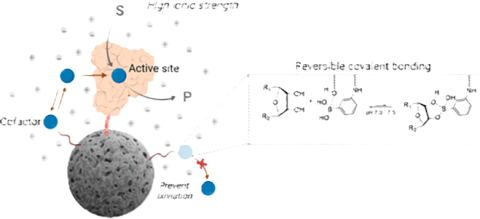Self-sufficient heterogeneous biocatalysts (ssHB) are promising candidates for implementing cofactor-dependent enzymes in chemical biomanufacturing. Most strategies for coimmobilizing cofactors with dehydrogenases on porous agarose microbeads involve the use of cationic polymers (i.e., polyethylenimine, PEI) that interact electrostatically with the phosphate groups of their corresponding phosphorylated cofactors. Although the latter is a powerful and versatile approach, ionic bonds are disrupted in biotransformations operating at a high ionic strength, where screening of bonded ions takes place. Harnessing the ribose groups present in adenylated cofactors, we immobilize a selection of these (NAD(P)H, NAD(P)+, FAD, and ATP) on agarose microbeads functionalized with boronic acid to establish reversible covalent bonds between the cis-diol of the ribose in the cofactor backbone and the boronic acid. To do so, we functionalize cobalt-activated porous agarose beads with boronic acid (AG-B/Co2+) for the coimmobilization of adenylated cofactors with the corresponding cofactor dependent His-tagged dehydrogenases. First, we demonstrate that the adenylated cofactor-support interactions are reversible but show resistance against high salt concentrations, overcoming the main limitation of the current self-sufficient heterogeneous biocatalysts. Then, we coimmobilized several His-tagged enzymes with their corresponding adenylated cofactors and investigated the functionality and stability of these ssHBs in reductive aminations performed under high ionic strength in both batch and flow reactors. As a result, we manage to reuse the immobilized enzymes and the cofactors 3.5 × 105 and 167 times, respectively. This work expands the usefulness of ssBHs for hitherto bioprocess regardless of the ionic strength of the media.

28/11/2023
Self-Sufficient Heterogeneous Biocatalysis through Boronic Acid-Diol Complexation of Adenylated Cofactors
Title: Self-Sufficient Heterogeneous Biocatalysis through Boronic Acid-Diol Complexation of Adenylated Cofactors
Journal: Acs Sustainable Chemistry & Engineering, 2023, 11, 39, 14409-14421. DOI: 10.1021/acssuschemeng.3c02958
